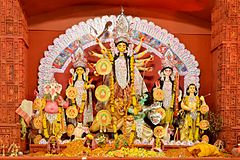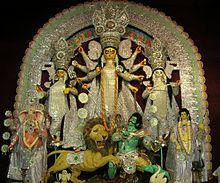Vijayadashami
| Vijayadashami विजयादशमी | |
|---|---|
 | |
| Also called | Dussehra, Navratri |
| Observed by | Hindus |
| Type | Religious |
| Significance | Celebrating victory of Shaktiover Mahishasura, of Lord Rama over Ravana, and ofDurga over demons like Mahishasura, Chanda-Munda and Shumbha- Nishumbha; that is victory of good over evil. |
| Celebrations | This day marks the end ofDurga Puja so people immerse the idols and go to each others' house and exchange gifts and sweets. |
| Observances | Putting Tilaka on forehead, prayers, religious rituals like burning an effigy of Ravana (see puja, prasad) |
| Date | Every year in October |
| 2014 date | 4 October 2014 |
| 2015 date | 22nd October 2015, Thursday 23rd October 2015, Friday[1] |
| 2016 date | 11th October 2016, Tuesday |
Ramayana, Shri Rama and Ravana Victory of Lord Rama over Ravana
As per Hindu religion, on this day in the Treta Yug, King Rama, also called Shri Ram, the seventh avatar of Vishnu, killed Ravana who had abducted Rama's wifeSita to his kingdom of Lanka. Rama, his brother Lakshmana, their followerHanuman and an army fought a great battle to rescue Sita. The entire narrative is recorded in the epic Ramayana, a Hindu scripture.
Rama had performed "Chandi Homa" and invoked the blessings of Durga, who blessed Rama with secret knowledge of the way to kill Ravana. On the day of Ashvin Shukla Dashami, Rama defeated Ravana and rescued Sita. Thus it is termed as Vijaya Dashami. Based on the inferences from Valmiki’s Ramayana, Kalidas’s Raghuvamsa, Tulsidas’s Ram Charit Manas, and Keshavdas's Ram Chandra Yas Chandrika as well as common perception in India, Rama, Sita, and Lakshmana returned to Ayodhya on the 30th day of Ashwin (19–20 days after Vijayadashmi). To mark the return of Lord Rama, in the evening, the residents of Ayodhya lit their city with millions of earthen lamps (called Deepak). Since then, this day is celebrated in India as Deepawali or Diwali.
Many people perform "Aditya Homa" as a "Shanti Yagna" and recite Sundara Kanda of Srimad Ramayana for 5 days. These Yagna performances are thought to create powerful agents in the atmosphere surrounding the house that will keep the household environment clean and healthy. These rituals are intended to rid the household of the ten bad qualities, which are represented by 10 heads of Ravana as follows:
- Kama vasana (Lust)
- Krodha (Anger)
- Moha (Attraction )
- Lobha (Greed)
- Mada (Over Pride)
- Matsara (Jealousy)
- Swartha (Selfishness)
- Anyaaya (Injustice)
- Amanavata (Cruelty)
- Ahankara (Ego).
Some householders perform Yagnas thrice daily along with Sandhya Vandana, which is also called Aahavaneeya Agni, Grahapatya Agni or Dakshina Agni. In addition, the Aditya Homa is performed with the Maha Surya Mantras and the Aruna Prapathaka of the Yajurveda. These mantras are believed to keep the heart, brain and digestive functions in balance in the absence of adequate sunlight in the winter months.
Victory of Durga Mata over Mahishasura
Main article: Mahishasura
See also: Maa Durga
Some of the demons, or Asuras, were very powerful and ambitious and continually tried to defeat the Devas, or Gods, and capture Heaven. One Asura, Mahishasura, grew very powerful and created havoc on the earth. Under his leadership, the Asuras defeated the Devas. The world was crushed under Mahishasura's tyranny, the Devas joined their energies into Shakti, a single mass of incandescent energy, to kill Mahishasura.
A very powerful band of lightning emerged from the mouths of Brahma, Vishnu andShiva and a young, beautiful female virgin with ten hands appeared. All the Gods gave their special weapons to her. This Shakti coalesced to form the goddess Durga. Riding on a lion, who assisted her, Durga fought Mahishasura. The battle raged for nine days and nights. Finally on the tenth day of Ashvin shukla paksha, Mahishasura was defeated and killed by Durga.
Hence Dasha-Hara is also known as Navratri or Durgotsav and is a celebration of Durga's victory. Durga, as Consort of Lord Shiva, represents two forms of female energy – one mild and protective and the other fierce and destructive.
Homecoming of Durga Mata
Main article: Maa Durga
Daksha, the Lord of the Earth, and his wife Prasuti, had a daughter called Sati. As a child, Sati started worshipping Lord Shiva as her would-be-husband. Lord Shiva was pleased with Sati's worship of him and married her. Daksha was against their marriage but could not prevent it. Daksha arranged a yagna to which everyone except Lord Shiva was invited. Sati, feeling ashamed of her father's behaviour and shocked by the attitude meted towards her husband, killed herself. Lord Shiva was anguished when he discovered this. He lifted Sati's body on his shoulders and started dancing. As the supreme power was dancing with wrath, the world was on the verge of destruction.
Then Lord Narayana came forward as a saviour and used his Chakra to cut Sati's body into pieces. Those pieces fell from the shoulders of the dancing Shiva and scattered throughout the Indian subcontinent. Shiva was pacified when the last piece fell from his shoulder. Lord Narayana revived Sati. The places where the pieces of Sati fell are known as the "Shakti Piths" or energy pits. Kalighat in Kolkata, Kamakshya near Guwahati and Vaishnav Devi in Jammu are three of these places.
In her next birth, Sati was born as Parvati or Shaila-Putri (First form of Durga), the daughter of Himavat, ruler of the Himalayas. Lord Narayana asked Shiva to forgive Daksha. Ever since, peace was restored and Durga with her children Kartikeya, Ganesh and her two sakhis – Jaya and Vijaya visit her parents each year during the season of Sharatkal or autumn, when Durga-Puja is celebrated.
End of Agyatawas of Pandavas
See also: Pandavas
In the age of Dvapara Yuga, Pandavas – the five acknowledged sons of Pandu (Sanskrit: पाण्डु ), by his wife Kunti – lost toKauravas in a game of dice, and both spent twelve years of Vanawas, or exile to the forest, followed by one year ofAgnyatawas. The brothers hid their weapons in a hole in a Shami tree before entering the Kingdom of Virat to complete the final year of Agnyatawas (exile incognito). After that year, on Vijayadashmi, they recovered the weapons, declared their true identities and defeated Kauravas, who had attacked King Virat to steal his cattle. Since that day, Shami trees and weapons have been worshipped and the exchange of Shami leaves on Vijayadashmi has been a symbol of good will and victory. This is also called Shami/Jambi Puja.
Kautsa's Guru Dakshina
Kautsa, the young son of a Brahmin called Devdatt, lived in the city of Paithan. After completing his education with Rishi Varatantu, he insisted on his guru accepting Guru Dakshina, a present. The guru said, "Kautsa, to give dakshina in return for learning wisdom is not appropriate. Graduation of the disciple makes the guru happy, and that is the real Guru Dakshina."
Kautsa was not satisfied. He still felt it was his duty to give his guru something. The guru said, "All right, if you insist on giving me dakshina, then give me 140 million gold coins, 10 million for each of the 14 sciences I have taught you."
Kautsa went to King Raghu. Raghuraja was an ancestor of Lord Rama, famous for his generosity. But just at that time he had spent all his money on the Brahmins, after performing the Vishvajit sacrifice. Raghuraja asked Kautsa to return in three days. Raghuraja immediately left to get the gold coins from Indra. Indra summoned Kuber, the god of wealth. Indra told Kuber, "Make rain full of gold coins, fall on the Shanu and Aapati trees around Raghuraja's city of Ayodhya."
The rain of gold coins began to fall. King Raghu gave all the coins to Kautsa, and Kautsa hastened to offer the coins to Varatantu Rishi. Guru had asked only 140 millions, so he gave the rest back to Kautsa. Kautsa was not interested in money, considering honour to be more valuable than wealth. He asked the king to take the remaining gold coins back. But the king refused, as kings do not take back the daan (gift).
Finally Kautsa distributed the gold coins to the people of Ayodhya on the day of Ashvin shukla dashami. In remembrance of this event, there has been a custom of plucking the leaves of the Aapati tree, and then people present these leaves to one another as gold.



No comments:
Post a Comment